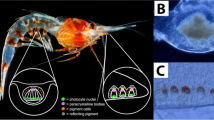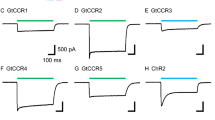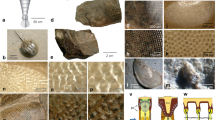Abstract
The giant clam Tridacna is a common shallow-water inhabitant of Indo-Pacific coral reefs1. These animals contain large populations of photosynthetic zooxanthellae in hypertrophied siphonal lobes which extend well beyond the edge of the shell for maximum exposure to light2–4 (Fig. 1). Protection for these large fleshy lobes is visually mediated and consists of a partial siphon retraction and valve adduction, a behaviour which gives rise to a forceful, startling jet of seawater5. Numerous eyes (up to several thousand in large animals6) located along the margin of the siphon comprise a visual system which presumably mediates the defensive withdrawal reflex. Here we present the first report on the physiological properties of the visual system in Tridacna. Intracellular electrophysiological recordings have revealed two distinct types of retinal cells: both are hyperpolarized by light but only one generates axonal spikes. We also describe cells with differential colour sensitivity, including receptors that are sensitive to ultraviolet (UV) light. Ultraviolet sensitivity, although not previously reported in molluscs7, may be an adaptation in Tridacna to the environmental requirements of a host for algal symbionts.
This is a preview of subscription content, access via your institution
Access options
Subscribe to this journal
Receive 51 print issues and online access
$199.00 per year
only $3.90 per issue
Buy this article
- Purchase on Springer Link
- Instant access to full article PDF
Prices may be subject to local taxes which are calculated during checkout
Similar content being viewed by others
References
Rosewater, J. Indo-Pacif. Mollusca 1, 347–396 (1965).
Yonge, C. M. Scient. Rep. Gt Barrier Reef Exped. 1, 283–321 (1936).
Yonge, C. M. Rec. aust. Mus. 33, 735–777 (1980).
Trench, R. K., Wethey, D. S. & Porter, J. W. Biol. Bull. 161, 180–198 (1981).
Stasek, C. R. Veliger 8, 29–35 (1965).
Fankboner, P. V. Veliger 23, 245–249 (1981).
Menzel, R. Handbook of Sensory Physiology Vol. VII/6A (ed. Autrum, H.) 503–580 (Springer, Berlin, 1979).
Stasek, C. R. Calif. Acad. Sci. occ. Pap. 58, 1–9 (1966).
McReynolds, J. S. & Gorman, A. L. F. J. gen. Physiol. 56, 376–391 (1970).
Shaw, S. R. J. Physiol., Lond. 220, 145–175 (1972).
Hartline, H. K. J. cell comp. Physiol. 11, 465–478 (1938).
Kennedy, D. J. gen. Physiol. 44, 277–299 (1960).
Wiederhold, M. L., MacNichol, E. F. Jr & Bell, A. L. J. gen. Physiol. 61, 24–55 (1973).
Barber, V. C. & Land, M. F. Experientia 23, 677–678 (1967).
Land, M. F. Symp. zool. Soc. Lond. 23, 75–96 (1968).
Jerlov, N. G. Nature 166, 111–112 (1950).
Smith, R. C. & Baker, K. S. Photochem. Photobiol. 29, 311–323 (1979).
Jokiel, P. L. Science 207, 1069–1071 (1980).
Halldal, P. Biol. Bull. 134, 411–424 (1968).
Author information
Authors and Affiliations
Rights and permissions
About this article
Cite this article
Wilkens, L. Ultraviolet sensitivity in hyperpolarizing photoreceptors of the giant clam Tridacna. Nature 309, 446–448 (1984). https://doi.org/10.1038/309446a0
Received:
Accepted:
Issue Date:
DOI: https://doi.org/10.1038/309446a0
This article is cited by
-
Light-enhanced phosphate absorption in the fluted giant clam, Tridacna squamosa, entails an increase in the expression of sodium-dependent phosphate transporter 2a in its colourful outer mantle
Coral Reefs (2020)
-
Giant clams in shallow reefs: UV-resistance mechanisms of Tridacninae in the Red Sea
Coral Reefs (2020)
-
The behaviour of giant clams (Bivalvia: Cardiidae: Tridacninae)
Marine Biology (2014)
-
Eavesdropping on visual secrets
Evolutionary Ecology (2013)
-
An opsin-based photopigment mediates phase shifts of the Bulla circadian pacemaker
Journal of Comparative Physiology A (1991)
Comments
By submitting a comment you agree to abide by our Terms and Community Guidelines. If you find something abusive or that does not comply with our terms or guidelines please flag it as inappropriate.



